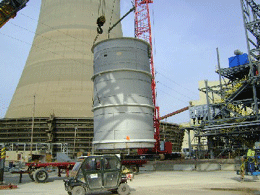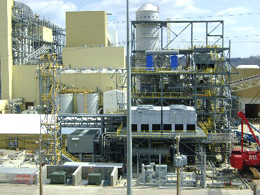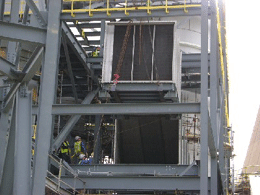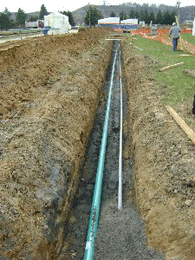Carbon Capture
Air Date: Week of June 26, 2009

A carbon capture absorber is put in a power plant. (Courtesy of American Electric Power)
About thirty percent of America’s carbon dioxide emissions come from coal-fired power plants. And since coal is cheap and abundant, big energy companies are feeling pressured to produce so-called “clean coal.” This fall, American Electric Power will test-run the first carbon capture and storage project at an existing U.S. power plant. AEP boasts their carbon removal process is the technology of the future, but critics charge it’s untested, expensive, and doesn’t address the environmental problems of mining for coal. Ann Murray reports.
Transcript
CURWOOD: It’s Living on Earth, I’m Steve Curwood.
Today the cheapest, most common way to generate electricity in the U.S. is the burning of coal.
But that poses health problems, and calorie for calorie, burning coal spews out three times as much of the greenhouse gas CO2 as the cleanest fossil fuels. And that has put coal under fire in the face of threatened climate disruption.
The Obama Administration recently revived FutureGen, a research project designed to show that a coal power plant can run cost-effectively without releasing CO2. And now there's a company that's becoming the first in the U.S. to retrofit an existing coal plant with carbon capture and storage.
Reporter Ann Murray has the story.
[TRUCKS BEEPING AND MOVING]
MURRAY: On a recent afternoon, trucks haul coal to a colossal storage pile at the Mountaineer power plant in New Haven, West Virginia. Each year, Mountaineer and 19 other plants owned by American Electric Power burn more than 75 million tons of coal to make electricity. Burning all that coal releases millions of tons of carbon dioxide. Mike Morris, American Electric Power’s CEO, says his company started thinking about that environmental connection years ago.

A view from the east of the Mountaineer Carbon Capture and Storage project. (Courtesy of American Electric Power)
MURRAY: Morris believes a carbon emission policy is in the cards for the United States. He’s betting AEP will reduce its carbon footprint with carbon capture and storage. His company’s pilot project will start up this fall at the 29-year-old Mountaineer plant. It'll be the first time an operating coal-fired power plant will capture and bury CO2 emissions.
[CONSTRUCTION WORKERS RIVETING STEEL]
MURRAY: Dozens of construction workers are now on site putting the pieces of the technology together.
SPITZNOGLE: They got a lot of steel on the ground and there’s still a lot more building left to do.

Workers install equipment at the Mountaineer CCS project. (Courtesy of American Electric Power)
SPITZNOGLE: The predominant thing you see is a big round tower that’s being built. That’s where the absorption happens.
MURRAY: Some of the plant’s emissions will be diverted to this five-story high tower. A chilled ammonia-based solvent will absorb the carbon dioxide there. Then the solvent will be heated to dissolve the CO2 out of the emissions. Spitznogle predicts this process will be a lot more energy efficient than other chemical absorption systems.

CO2 transport line at AEP's Mountaineer facility. (Courtesy of American Electric Power)
MURRAY: The CO2 will be compressed into a liquid, piped a short distance and injected into a deep storage well.
[SOUND OF GATE OPENING]
MURRAY: Back on the ground, Spitznogle opens a gate next to the wellheads. He says deep layers of porous rock will hold the CO2. Thousands of feet of dense shale above that will keep it in place. Nobody knows for sure if the gas will stay trapped permanently.
MURRAY: Why are you guessing that this is going to work?
SPITZNOGLE: Well, I wouldn’t use the term guess. This is kind of an extrapolation of what’s been done in the oil and gas industry for enhanced ore recovery. They actually inject CO2 and use it to push oil out of the ground.
MURRAY: AEP and a partner have invested 100 million dollars in this phase of the project. If it’s successful, the company hopes to get government help with the 300 to 500 million dollars needed to capture about 20 percent of Mountaineer’s CO2 . AEP’s ultimate plan is to fully retrofit one of their plants and capture 90 percent of its carbon. At every stage, the company believes it will take 15 to 20 percent of the plant’s power output to run the process. Energy analysts say the completed system could cost around a billion dollars. Even at that price, Mike Morris is convinced this carbon capture and storage technique will be cost effective for his company and other existing coal-fired power plants.

Part of carbon capture absorber being put into place at American Electric Power's Mountaineer facility. (Courtesy of American Electric Power)
MURRAY: Not every power company wants to make that leap. Some say that the technology is too expensive to perfect. Duke Energy, a major electricity provider, recently announced that it’s betting on nuclear power instead of pursuing carbon capture and storage. American Electric Power and the independent Electric Power Research Institute predict once their carbon capture system is fully operational, customers will pay about ten cents a kilowatt-hour. That’s five cents more than the cost of electricity from traditional coal-fired plants. And it’s three to four cents higher per kilowatt-hour than nuclear-powered energy and subsidized wind generation. Many industry experts anticipate the expense of building and running carbon capture systems at a commercial capacity will delay widespread use of the technology for several decades.
Some environmental groups object to the technology because of the harmful impacts of mining. Raina Rippel is the director of the Center for Coalfield Justice, a grassroots organization.
RIPPEL: This idea that carbon capture and sequestration is this silver bullet is just false. It doesn’t address the whole coal cycle. It doesn’t address the fly ash. It doesn’t address the mining impacts. It’s almost too little too late.
MURRAY: Rippel deals with the impacts of mining every day.
[BIRDS CHIRPING AND DOG BARKING]
MURRAY: Today, she’s in a neighborhood in southwestern Pennsylvania located above a Longwall mine. Longwall mining operations remove huge panels of coal buried deep underground. That causes the land above the mined area to drop. Aimee Erikson’s house dropped six inches days after her property was undermined. She shows Rippel raw sewage in her yard.
ERICKSON: The septic tank is located in the corner of my house where the house dropped the most. Smelling this constantly is disgusting.
MURRAY: Coalfield Justice’s Rippel says she sees hundreds of people like Amy Erikson with mining damage to their homes, businesses and water supplies. She believes investing in carbon capture and storage technologies will only slow down the transition to cleaner, low impact energy sources.
RIPPEL: I just think that carbon capture and sequestration is the anti-vision. It will tie us to the past.
RUBIN: As much as we wish we could wave a magic wand and replace fossil fuels with so-called clean renewables, there is no such magic wand.
MURRAY: Ed Rubin is a professor in Carnegie Mellon University’s Department of Engineering and Public Policy. Rubin sees coal as a major player in the US energy mix for decades. He isn’t nearly as sure that the widespread use of carbon capture at coal-fired plants is at hand. He says that two things have to happen to push the technology. First, the entire process: carbon capture, transport of the CO2 and storage must be shown to work safely and effectively at a commercial scale.
RUBIN: The second is public policy. Right now there’s no requirement for power plants or for anybody else for that matter to reduce CO2 emissions.
MURRAY: Some energy experts predict it could take 10 to 20 years and cost billions to learn if carbon capture and storage is commercially viable. Currently, Congress and President Obama are in the process of moving legislation to curb CO2 emissions. American Electric Power’s Mike Morris believes legislation will encourage carbon- limiting technologies and he’s on board.
MORRIS: It is not inexpensive. But it is doable. And society - American society, needs to decide that’s the way they want to go.
MURRAY: In the meantime, the federal stimulus package includes 2.4 billion dollars for "clean coal" projects. And the Department of Energy has offered at least six billion dollars in loan guarantees for existing coal-fired plants that use carbon capture and storage--signs that the pieces of the carbon capture puzzle might be falling into place for companies like American Electric Power.
For Living on Earth, I’m Ann Murray.
Links
Living on Earth wants to hear from you!
Living on Earth
62 Calef Highway, Suite 212
Lee, NH 03861
Telephone: 617-287-4121
E-mail: comments@loe.org
Newsletter [Click here]
Donate to Living on Earth!
Living on Earth is an independent media program and relies entirely on contributions from listeners and institutions supporting public service. Please donate now to preserve an independent environmental voice.
NewsletterLiving on Earth offers a weekly delivery of the show's rundown to your mailbox. Sign up for our newsletter today!
 Sailors For The Sea: Be the change you want to sea.
Sailors For The Sea: Be the change you want to sea.
 The Grantham Foundation for the Protection of the Environment: Committed to protecting and improving the health of the global environment.
The Grantham Foundation for the Protection of the Environment: Committed to protecting and improving the health of the global environment.
 Contribute to Living on Earth and receive, as our gift to you, an archival print of one of Mark Seth Lender's extraordinary wildlife photographs. Follow the link to see Mark's current collection of photographs.
Contribute to Living on Earth and receive, as our gift to you, an archival print of one of Mark Seth Lender's extraordinary wildlife photographs. Follow the link to see Mark's current collection of photographs.
 Buy a signed copy of Mark Seth Lender's book Smeagull the Seagull & support Living on Earth
Buy a signed copy of Mark Seth Lender's book Smeagull the Seagull & support Living on Earth

